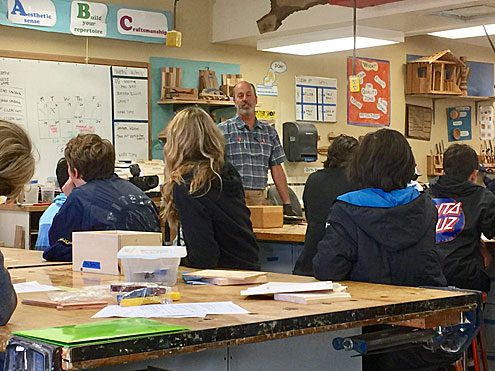By Scott Turnbull, Superintendent Soquel Union Elementary School District
Limit Screen Time
Personalized Learning
Cross-Curricular Lessons
Integrated Learning
Delayed Gratification
Teaching Patience
Developing Focus
Hands-On Learning

That brings me to two programs at New Brighton Middle School that provide just the types of experiences for students that we are looking for. There’s the Woodshop Program instructed by Mr. David Brodkey and the Art Program instructed by Mr. Roy Segura. I recently spent some time in these classes and walked away feeling a great sense of pride. Mr. Brodkey and Mr. Segura are instructors in every sense of the word. Mr. Segura regularly weaves in Science and Social Studies while showing students proper brush strokes. Mr. Brodkey has developed a video library of his lessons allowing him to help students virtually at the same time he’s helping others in real-time.
The arts are a vital part of education and Soquel District, along with parents, has recognized its value by supporting the programs throughout the years. Among the many ways art education improves learning are: collaborating on ideas, persevering with learned skills, aiding to focus, contributing to decision making, understanding and evaluating historical movements and ideologies, improving coordination, and creating works of art. In a world pushed by digital skills, it is good to see that the “hands-on” skills in humanity are still valued as an integral part of education. Students in Art Class told me some of their favorite projects included the bamboo flat brush and shading projects. And all those beautiful murals you see at our schools are the work of Mr. Segura himself.
Woodshop, for 6th graders, is a 9-week introductory course that includes practical skills such as knot tying and wiring a lamp along with woodworking. Almost all 6th graders participate in this class as part of their elective rotation. Then, if they choose to take it, the course for 7th and 8th graders lasts an entire semester; the first half of the class includes projects designed to teach students how to use all the tools safely so that they can choose their own projects to complete in the second half. In addition, ten students per year act as classroom aides, providing key support to keep the shop organized and to give valuable assistance to their peers as they work on their projects.
Along with the skills of woodworking, the class emphasizes development of a sense of competence, excellence, and creative problem solving that will serve the kids well in whatever endeavors they may pursue. Students are given a high degree of independence and responsibility, which facilitates an engaging atmosphere that most enjoy and thrive in. They learn to manage their time, deal with setbacks, develop their aesthetic sense, and experience the joy and satisfaction of creating something from scratch with their own hands.
Lilah is an 8th Grade Student who currently serves as Mr. Brodkey’s Aide during second period Woodshop. She told me that when she first took Woodshop Class as a 6th grader she was nervous for a couple of days and then learned to love the class. She took it again in 7th grade because she liked the feeling of being responsible enough to be trusted with all of the tools in the class. Now she’s an Aide in the class and it was impressive to watch her coach several other students who needed a little help.
As Superintendent I am very grateful to the current SUESD Board of Trustees, previous boards, and previous district administrators who have protected these programs over the years. In the leanest financial years it is often programs like these that get pushed aside. I feel most fortunate that SUESD decision-makers realized the value of the programs taught by Mr. Segura and Mr. Brodkey and found a way to sustain them. Our students are the beneficiaries.
A final anecdote that brings home the need for these types of classes is one relayed to me by SUESD Personnel Coordinator, Janine Blaesser. Mrs. Blaesser’s children (now adults) all went through SUESD schools. Her daughter Katie (pictured in hard hat) is now a Structural Engineer in Seattle and credits New Brighton’s Woodshop Class as the inspiration for her career path. Mrs. Blaesser indicated that as a parent she loved the way the class empowered her then-teenage daughter. In fact, Mrs. Blaesser still keeps the duck (pictured) that “started it all” as a keepsake in her office.